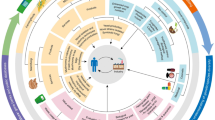Abstract
Myxococcus xanthus is a prime example of soil-living myxobacteria featuring a complex lifestyle, including coordinated movement through swarming, predatory feeding on other microorganisms, and the formation of multicellular fruiting bodies. Due to its biosynthetic capabilities for secondary metabolite production and its applicability as biotechno-logical chassis organism for heterologous expression, Myxococcus stands out as a biochemical factory for bioactive molecules with future applications, not only in human therapy.
Article PDF
Similar content being viewed by others
Avoid common mistakes on your manuscript.
Literatur
Muñoz-Dorado J, Marcos-Torres FJ, García-Bravo E et al. (2016) Myxobacteria: moving, killing, feeding, and surviving together. Front Microbiol 7, doi: https://doi.org/10.3389/fmicb.2016.00781
Goldman BS, Nierman WC, Kaiser D et al. (2006) Evolution of sensory complexity recorded in a myxobacterial genome. Proc Natl Acad Sci USA 103:15200–15205
Xiao Y, Wei X, Ebright R et al. (2011) Antibiotic production by myxobacteria plays a role in prédation. 1 Bacteriol 193:4626–4633
Krug D, Zurek G, Revermann O et al. (2008) Discovering the hidden secondary metabolome of Myxococcus xanthus: a study of intraspecific diversity. Appl Environ Microbiol 74:3058–3068
Meiser P, Bode HB, Müller R (2006) The unique DKxanthene secondary metabolite family from the myxobac-terium Myxococcus xanthus is required for developmental sporulation. Proc Natl Acad Sci USA 103:19128–19133
Cortina NS, Krug D, Plaza A et al. (2012) Myxoprincomide: a natural product from Myxococcus xanthus discovered by comprehensive analysis of the secondary metabolome. Angew Chem Int Ed 51:811–816
Dickschat IS, Wenzel SC, Bode HB et al. (2004) Biosynthesis of volatiles by the myxobacterium Myxococcus xanthus. Chembiochem 5:778–787
Hoffmann M, Auerbach D, Panter F et al. (2018) Homospermidine lipids: a compound class specifically formed during fruiting body formation of Myxococcus xanthus DK1622. ACS Chem Biol 13:273–280
Hug II, Panter F, Krag D et al. (2019) Genome mining reveals uncommon alkylpyrones as type III PKS products from myxobacteria. J Ind Microbiol Biotechnol 46:319–334
Sucipto H, Pogorevc D, Luxenburger E et al. (2017) Heterologous production of myxobacterial a-pyrone antibiotics in Myxococcus xanthus. Metab Eng 44:160–170
Pogorevc D, Panter F, Schillinger C et al. (2019) Production optimization and biosynthesis revision of coral-lopyronin A, a potent anti-filarial antibiotic. Metab Eng 55:201–211
Herrmann I, Fayad AA, Müller R (2017) Natural products from myxobacteria: novel metabolites and bioactivities. Nat Prod Rep 34:135–160
Funding
Funding: Open Access funding provided by Projekt DEAL.
Author information
Authors and Affiliations
Corresponding author
Additional information
Daniel Krug1997–2003 Chemiestudium an der TU Braunschweig. 2004–2009 Promotion am Institut für Pharmazeutische Biotechnologie an der Universität des Saarlandes. Seit 2009 Wissenschaftler am Helmholtz-Institut für Pharmazeutische Forschung Saarland (HIPS) in Saarbrücken.
Ronald Garcia1999–2003 Mikrobiologiestudium an der Universität Santo Tomas, Manila, Philippinen. 2011 Promotion an der Universität des Saarlandes und am Helmholtz-Institut für Pharmazeutische Forschung Saarland (HIPS). Seit 2012 Wissenschaftler am HIPS und seit 2016 am Deutschen Zentrum für Infektionsforschung (DZIF).
Rolf Müller1986–1990 Pharmaziestudium an der Universität Bonn, dort 1994 Promotion. 1996–1997 Postdoc in Seattle, USA. 1998–2003 Juniorgruppenleiter an der Gesellschaft für Biotechnologische Forschung in Braunschweig. Seit 2003 Professor für Pharmazeutische Biotechnologie an der Universität des Saarlandes und seit 2009 Gründungsdirektor des Helmholtz-Instituts für Pharmazeutische Forschung Saarland (HIPS).
Rights and permissions
Open Access: Dieser Artikel wird unter der Creative Commons Namensnennung 4.0 International Lizenz veröffentlicht, welche die Nutzung, Vervielfältigung, Bearbeitung, Verbreitung und Wiedergabe in jeglichem Medium und Format erlaubt, sofern Sie den/die ursprünglichen Autor(en) und die Quelle ordnungsgemäß nennen, einen Link zur Creative Commons Lizenz beifügen und angeben, ob Änderungen vorgenommen wurden. Die in diesem Artikel enthaltenen Bilder und sonstiges Drittmaterial unterliegen ebenfalls der genannten Creative Commons Lizenz, sofern sich aus der Abbildungslegende nichts anderes ergibt. Sofern das betreffende Material nicht unter der genannten Creative Commons Lizenz steht und die betreffende Handlung nicht nach gesetzlichen Vorschriften erlaubt ist, ist für die oben aufgeführten Weiterverwendungen des Materials die Einwilligung des jeweiligen Rechteinhabers einzuholen. Weitere Details zur Lizenz entnehmen Sie bitte der Lizenzinformation auf http://creativecommons.org/licenses/by/4.0/deed.de.
About this article
Cite this article
Krug, D., Garcia, R. & Müller, R. Myxobakterielle Naturstofffabriken. Biospektrum 26, 32–36 (2020). https://doi.org/10.1007/s12268-020-1334-1
Published:
Issue Date:
DOI: https://doi.org/10.1007/s12268-020-1334-1




